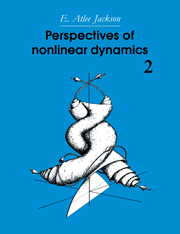Book contents
- Frontmatter
- Contents
- Preface
- Acknowledgements
- 6 Models based on second order difference equations
- 7 Models based on third order differential systems
- 8 ‘Moderate-order’ systems
- 9 Solitaires: solitons and nonsolitons
- 10 Coupled maps (CM) and cellular automata (CA)
- Epilogue: ‘Understanding’ complex systems: Order; organization; Endnote–models, causality, irreversibility
- Appendixes
- Bibliography
- References added at 1991 reprinting
- Cumulative index (Volumes 1 and 2)
9 - Solitaires: solitons and nonsolitons
Published online by Cambridge University Press: 19 February 2010
- Frontmatter
- Contents
- Preface
- Acknowledgements
- 6 Models based on second order difference equations
- 7 Models based on third order differential systems
- 8 ‘Moderate-order’ systems
- 9 Solitaires: solitons and nonsolitons
- 10 Coupled maps (CM) and cellular automata (CA)
- Epilogue: ‘Understanding’ complex systems: Order; organization; Endnote–models, causality, irreversibility
- Appendixes
- Bibliography
- References added at 1991 reprinting
- Cumulative index (Volumes 1 and 2)
Summary
In this chapter we will consider a limited, but important class of nonlinear wave phenomena which are described, of course, by partial differential equations (PDE). The phenomenon of interest is the occurrence of localized, traveling disturbances, which retain their structure due to nonlinear effects. These solitary disturbances (‘solitaires’) may occur in a variety of systems; solids, hydrodynamics, plasmas, biological molecules, optical systems, various field theories, etc., and are therefore of great interest in many forms of ‘transport’ or ‘communication’ phenomena. Of particular interest is that, in many systems, these solitaires can retain their identity (shape and velocity) even after they collide with each other – which gave rise to the term ‘soliton’. In other systems, different solitaires can annihilate each other, or interact in more complicated two-dimensional processes.
We will examine some of these features, beginning with the historical approach of Zabusky and Kruskal (1964), which was stimulated by the Fermi–Pasta–Ulam recurrence phenomenon, discussed in the last chapter. This historical approach is by no means the most sophisticated mathematical introduction to this subject, but instead retains some of the flavor of the original discovery, including some analysis with obscure motivation (until, of course, everything fell into place!). Hopefully the reader will find some heuristic value and stimulation in following this bumpy road to discovery – if not, some of the following sections may be omitted (as noted below).
The study of nonlinear, solitary, propagating disturbances has a long history, particularly in the field of fluid dynamics. Much of this history is reviewed by Scott, Chu, and McLaughlin (1973), with additional details concerning the research of D.J. Korteweg and his student, G. deVries, given by van der Blij (1978).
- Type
- Chapter
- Information
- Perspectives of Nonlinear Dynamics , pp. 348 - 426Publisher: Cambridge University PressPrint publication year: 1990
- 1
- Cited by

